2020 Review of New Spectroscopic Instrumentation
Spectroscopy
Our annual review of products introduced at Pittcon or during the previous year.
We present our annual review of products introduced at Pittcon or during the previous year, broken down by the following categories: accessories, atomic spectroscopy, components, imaging, mass spectrometry, mid-infrared (mid-IR) spectroscopy, near-infrared (NIR) spectroscopy, nuclear magnetic resonance (NMR), Raman spectroscopy, software, ultraviolet-visible (UV-vis) spectroscopy, and X-ray.
This review focuses on new instrumentation, components, and accessories launched from May 2019 through April 2020, announced either directly to Spectroscopy through form submissions or by those presented as new at the recent Pittsburgh Conference (Pittcon) in Chicago, Illinois, where we spoke directly with vendors.
This year’s Pittcon was interrupted by a larger societal concern-the sudden spread of the coronavirus. Pittcon was not canceled, but many exhibitors chose not to attend. Even so, there were still a large number of exhibitors, representing a cross section of the industry (from smaller suppliers to large instrument companies). The total attendance, reported as 9011, was, nevertheless, quite respectable, despite the challenges.
In this review, we are interested only in products that fall under the umbrella of spectroscopy, whether they be instruments, components, accessories, standards, software, or anything else related to spectroscopic measurement.
Excellence Awards at Pittcon 2020
One of the points of interest at Pittcon is the awards for instruments considered the most innovative. This evaluation is, of necessity, subjective, and involves a selection from among all the instruments on display at Pittcon. Starting three years ago, the selection methods and criteria were changed, and the awards are now called the Pittcon Today Awards. A selection committee, consisting of a blue-ribbon panel of experts, evaluates the entries based on ingenuity, creativity, implementation, and outcomes. Instruments are categorized by the size of the company (small, medium, and large) that makes them, based on their sales figures. This allows companies to compete with others in their same class. There are gold, silver, and bronze awards in each category, for a total of nine awards. We are pleased that this year four awards went to spectroscopy instruments. In the small company category, Waveguide won the gold for world’s first small, battery-powered, handheld NMR instrument and Aeris Technologies won bronze for a real-time mid-IR-based ultrasensitive ethylene oxide gas analyzer. In the large-company category, Bruker won gold for its Lumos 2 FT-IR microscope, and Horiba won bronze for the LabRam Soleil instrument that combines Raman, UV-vis, and NIR spectroscopy.
The review that follows is organized alphabetically by wavelength region or type of spectroscopy-for example, mid-infrared (IR), Raman, X-ray, and so forth-except that we place the two non-instrument categories (accessories and components) at the end. Table I sorts the companies alphabetically, and lists the categories they appear in. We arrange our review to allow readers to compare instruments from different manufacturers, although this process sometimes classifies low-end handheld instruments with high-end research tools. The categories used to classify the products are:
Atomic spectroscopy
- Imaging
- Mass spectrometry (MS)
- Mid-infrared (mid-IR) spectroscopy
- Near-infrared (NIR) spectroscopy
- Nuclear magnetic resonance (NMR)
- Raman spectroscopy
- Software
- UV-visible spectroscopy
- X-ray
- Accessories
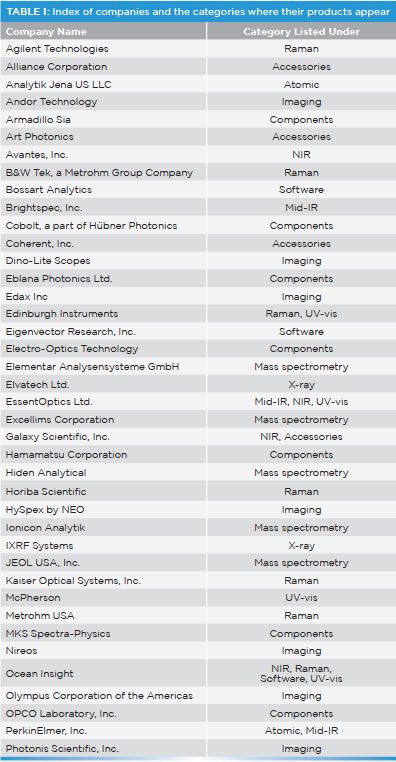
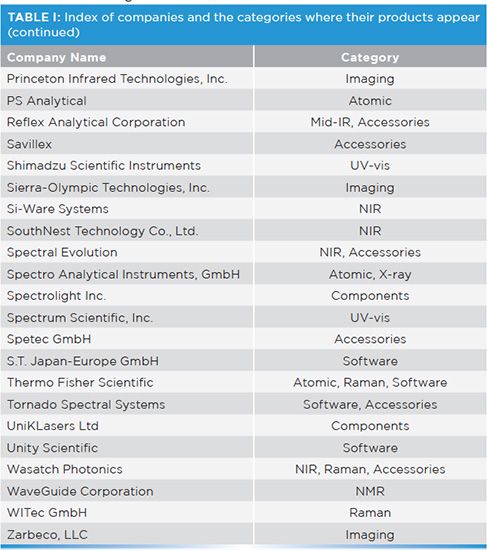
Components
Our categories fluctuate from year to year, depending on trends in the submissions. The core spectroscopy headings are consistent, but the imaging category, for example, has been transient. This year, we received enough products classified as imaging to warrant that being a category in itself, rather than only including imaging versions of various technologies under the parent instrument type. Fluorescence was a popular category some time ago, but has fallen out of favor for several years. Last year it returned, but that proved to be only temporary; this year, there were again no submissions in that category, despite its analytical popularity and presence at trade shows.
As in the past, accessories are tools used with an instrument-like sample preparation or optical devices-whereas components are parts used as integral parts within instruments, like lasers or detectors. The software category includes instrument control and data processing, storage, and transmission, as well as spectral databases (libraries) and other collections of specialized information, besides programs that analyze the data.
Overview: Trends
One of our goals in writing this instrumentation review, as well as spending time at instrumentation trade shows (such as Pittcon), is to identify larger themes from the aggregation of submissions.
Some years ago, we had seen environmental solutions trending, especially around microplastics. This year, environmental issues were muted under the public health solutions around opioids, cannabis, and COVID-19. The plenary lecture at Pittcon, and many hallway conversations, were dominated by these subjects, and vendors were touting testing and research tools. The absence of several vendors, especially from Asia and some parts of Europe (and the reticence of attendees to shake hands), put an exclamation point on this.
Within the instrument submissions themselves, we see many tools and instruments relating to Raman spectroscopy. We discuss this further in the Raman spectroscopy section, but note here that component and accessory suppliers, as well as instrument manufacturers, have identified Raman spectroscopy as a significant market. Overall, we saw in recent years many handheld instruments and new laser sets, and also found that large instruments and software were prevalent
this year.
In the expanding world of software, we reported last year on the emerging uses of computers in artificial intelligence (AI) applications and integrating with the internet of things (IoT), as expansion of IoT is starting to come to fruition, albeit not as soon as we originally expected. We note this in our
review below.
One continuing trend was the combination of various technologies into a single instrument. Several companies, for example, are now combining Raman spectroscopy with other optical spectroscopies, such as UV-vis or infrared. These combinations are often augmented with special software to enable the instrument control computer to find commonalities or other relationships between the spectra produced by the different technologies. Some details about this are apparent in the Raman spectroscopy section of
this review.
Vendors have all identified the trend in many laboratories of downsizing staffing, even with a continued increase in sample loads. This means a single worker must be able to move between multiple instruments without major barriers. Easy sample transfer and shallow learning curves via workflow software are becoming common needs. With instrument vendors, this information is often buried, both in their product development and their marketing literature, under the prevalent and long-standing emphasis on hardware performance (signal-to-noise, resolution, speed, and so forth), but it becomes immediately apparent when you watch vendors demonstrate their instruments. The demonstration is increasingly a software show. This trend is discussed further in the software section of this review.
This year, we added a new tactic for the trend predictions. We contacted subject-matter experts to discuss future trends in their technologies. We thought that people working in the same area might be seeing the same forces affecting their technology. Below, we share some of the responses we received to this inquiry. Because these comments represent opinions rather than hard facts, to preserve privacy, we do not identify the company or person responding with each comment, but we list the expected trends for the technology. For those companies that responded to this question and have multiple products, their response is listed under the technology category that their instrument containing the response belongs.
Imaging
- “[There is] a general trend towards higher resolution X-ray and neutron indirect detection cameras.”
- “[There is a] continuous trend of improving the data storage, handling, and processing allowed hyperspectral imaging to take place as it generates very heavy images. One image captured by [trade-name redacted] can require 1 Gb [of data], as it contains a lot of information of a scene.”
- “Shortwave infrared (SWIR) imaging is growing in many biological and chemical analysis applications.”
Mid-IR spectroscopy
- “Rapid growth of several industrial market segments (including chiral chemicals, asymmetric synthesis, cannabinoids, essential oils, and others) have created a strong demand for analytical techniques capable of fast isomer-selective chemical analysis. The emerging [trade-name redacted] technology addresses this demand, … offer[ing] extraordinary chemical specificity combined with fast analysis and ease of use.”
- “Photonics devices [will] become much more advanced. This requires [technicians] to use optical components with extreme specifications. These specifications need to be measured and confirmed, so this leads to design of more advanced metrology and testing equipment.”
NMR
- “Close to 20 years ago, the first portable X-ray fluorescence (XRF) devices were released for easy-to-use metal and mining applications for non-scientific users. A decade ago, there was a strong thrust into the portable optical/vibrational spectroscopy market, with Raman, NIR, and FT-IR for safety, security, military, and pharmaceutical raw-material ID analysis. One company [name redacted] extends this portable theme further with the world’s first portable NMR, which addresses the gaps of XRF and optical and vibrational [spectroscopy] in the areas of biologics, vaccines, foods, and, ultimately, in medical diagnostics. The theme or trend is routine chemical screening and non-scientific operators who need to make a fast and precise decision at the point of need.”
Raman spectroscopy
- “The pharmaceutical industry is not making large investments at this time, as market consolidation and acquisitions are on the rise in this sector. The demand for field identification of controlled substances and threats is global, with needs specific to geographic regions. Investment in technology is tied to national budgets, and therefore impacted by geopolitical and global economic trends.”
- “With continued improvements in Raman technology, more sophisticated trace-level and low-concentration measurements are becoming possible.”
- “Automation is among the most important long-term trends in the development of scientific instruments. Using optimization and calibration routines, along with pre-set and saved experimental workflows, reduces input demands on the researcher, while allowing them to focus on the data they acquire. Errors are minimized, while operational turnover is maximized, enabling laboratories and user facilities to generate more, and more consistent, data within a given amount of time.”
- “I am seeing increasing interest in
- cloud-based analytical solutions-instrument management and reporting, mostly-from both customers and
- multiple vendors.”
Software
- “Hyperspectral imaging is [a] growing field that is finding applications in processing, medical imaging, environmental applications, and earth sensing. [Trade-name redacted] allows incorporation of domain knowledge necessary for interpretable results required by engineers and scientists.“
- “Chemometrics is falling under a broader field of data science and machine learning. In addition to AI tools, our package is more flexible than most tools, and allows incorporation of domain knowledge necessary for interpretable results required by engineers and scientists.”
- “The increasing development of handheld or smaller sized spectrometers.”
- “NIR in general is moving away from technology experts with years of training and experience, to users of the technology that need to get results. [Company name redacted] is responding by creating intuitive products that provide top performance and capabilities in a user-friendly format.”
- “[Increasing use of the] home office.”
UV-vis spectroscopy
- “General optimism and more government money being spent in science, especially [in the fields of] astrophysics and physics. For example, more of our customers are getting funded via National Science Foundation/Department of Energy, and even NASA.”
Components
- “[Technology] is driving toward ever-lower scatter, while demanding high efficiency.”
Accessories
- “Today’s trace metals analysis laboratories are constantly being driven to achieve lower levels of detection, which, in turn, put greater demand on clean chemistry techniques and applications.”
- “Increasing automation in the laboratory has led to a demand for easy-to-operate pumping systems that do not require pressure to be set individually.”
Some current (and even past) practices may become future trends, if and when they become more widespread and generalized. In the meanwhile, sporadic mentions of these practices appear in advertisements, in scientific literature, and even in this review. For example, some instrument manufacturers have created a capability of remotely controlling and collecting data from their own instruments (networking) for a long time. As we said last year, when that capability expands to include more than one type of instrument, then it would be fair to rename that localized networking as belonging to IoT, but not until then. Similarly, can the current capabilities of the application of chemometric analysis to instrument data, to perform quantitative and qualitative analysis, be called AI?
As we have noted almost since we first started trying to detect instrument trends, the trend toward hyphenated techniques has been coming along slowly, but surely, over the years. A recent twist on that concept, broadening the idea of applying multiple technologies to an analysis, is the packaging of dissimilar, and indeed sometimes even orthogonal, technologies in a single instrument package, without the two technologies necessarily interacting (as hyphenated methods do). We first noted this trend several years ago, but, even in last year’s review, there was only one example of this combining of technologies, With hindsight, we can see the beginnings of this trend several years ago, when Raman spectroscopy was combined with an atomic force microscope (AFM) in one unit. In this review, there are multiple companies demonstrating combined technologies; interestingly, all of them include Raman spectroscopy as one of the technologies.
Some other potential miscellaneous trends can be seen if you keep your eye tuned for them, one of them being a change in the nature of applications from being chemistry-focused to becoming more focused toward biochemical and biomedical applications.
Review of New Products for 2020
Atomic Spectroscopy
Both Thermo Fisher Scientific and Perkin
Elmer introduced new inductively coupled plasma (ICP) solutions, striving for increased sensitivity and speed. In presenting these instruments, these companies focus on use in a wide range of markets (including lubrication, pharmaceuticals, and environmental markets). In contrast, PS Analytical focuses on mercury monitoring, with a continuous operations profile.
Analytik Jena announced two atomic emission spectrometers, one with multi-element, multisource, multidetector capability.
PS Analytical manufactures mercury monitors for water and air monitoring. Features include automatic self-calibration, ultralow limits of detection (LOD), and low reagent usage.
PerkinElmer has a new ICP-mass spectrometer (ICP-MS) with a four-quadrupole mass spectrometer. They also launched a unit that combines ICP-OES and a liquid particle counter, following the trend of combining different technologies into a single system, as discussed in the introduction, but the only such instrument in this review that does not include Raman spectroscopy as one of the technologies.
Spectro Analytical has developed a series of OES spectrometers, each with specialized functionality.
Thermo Fisher displays a new ICP-OES spectrometer with enhanced capabilities over previous models.
See Table II for listings of atomic spectrometers.
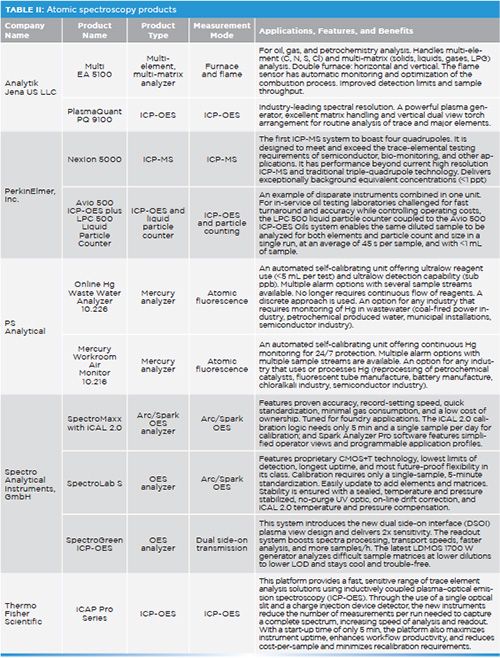
Imaging
The products listed under imaging are all cameras, with and without microscopes. The key improvements are around sensitivity and, more often, speed, which is crucial for these systems, enabling larger areas to be imaged, and a wider range of applications. This is true regardless of spectral range (X-ray to IR).
Andor provides an X-ray camera (Balor-X) that combines a large 16.9 megapixel sensor with the fast readout speed of sCMOS technology, giving 54 FPS at full frame.
Dino-Lite Scopes provide digital imaging microscopes with video interfacing to a PC or Mac.
Edax offers what it is marketing as the fastest EBSD camera on the market, the Velocity Camera Series, offering high-speed EBSD mapping with the best indexing performance on real world materials.
HySpex industrial hyperspectral imagers are fast, flexible, robust, and repeatable, with spectral resolution of two bands, capturing 4X more light.
Nireos provides imaging using a Fourier-transform approach. This approach gives very high sensitivity in a small and light instrument. Spectral resolution is exceptional: <1 nm at 400 nm wavelength. It captures images in a static regime.
Olympus Corporation of the Americas enables measurement and observation of a variety of materials with interactive zoom and guaranteed high- and low-magnification accuracy and precision using a single instrument.
Photonis Scientific provides a single-photon-counting camera with nanosecond time-stamping and <10 µm spatial resolution. Mantis3 consists of a Timepix3-based visible light camera coupled to a Cricket, containing a high-end image intensifier.
Princeton Infrared Technologies offers a compact SWIR–visible camera that supports the 95 FPS frame rate at megapixel resolution with no ITAR restrictions, with high resolution (1280 x 1024 pixels) SWIR imagery.
Sierra-Olympic provides a mid-IR imaging camera with the smallest, lightest, most power-efficient camera in the Ventus product line, offering continuous zoom, one-touch autofocus, advanced image processing, and several other features
Zarbeco LLC offers a palm-sized portable USB3-powered digital microscope featuring 400x magnification, resolution to 1 µm, 13 MP, true 4K resolution, up to 60 fps, and optional UV or IR multispectral imaging. The software facilitates averaging for low light, side-by-side comparisons, calibrated overlays, and a magnifier window for precision measurement.
See Table III for listings of imaging devices.

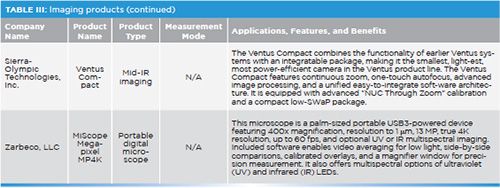
Mass Spectrometry
Size and sensitivity were major themes for the mass spectrometry (MS) offerings. There is also a unique analyzer specific for honey (Elementar). This category has responded to the general instrumental trend toward smaller laboratory settings with the same or higher sample loads, demanding space-saving solutions. A major advantage of MS over other techniques is extreme sensitivity. Downsizing the system allows for smaller vacuum systems (pumps), due to decreased volume. This trend will continue as the importance of MS in many fields continues to grow.
Elementar Analysensysteme GmbH uses high temperature to generate ions, whose isotope ratios are subsequently detected by MS, to determine adulteration of honey.
Excellims combines its mobility technology with a miniaturized ion-trap mass spectrometer to create a small-footprint, miniaturized instrument. They also offer an autosampler accessory.
Hiden provides a variety of configurations of their mass spectrometers,
each promoted and optimized for a
different application.
Ionicon offers two new time-of-flight (TOF) mass spectrometers with extremely high sensitivities and correspondingly low limits of detection.
JEOL provides an imaging matrix-assisted laser desorption ionization (MALDI)-TOF/TOF mass spectrometer with ultrahigh mass-resolving power and an optional MS/MS with unit-mass precursor selection for imaging samples that are not perfectly flat.
See Table IV for listings of mass spectrometers.
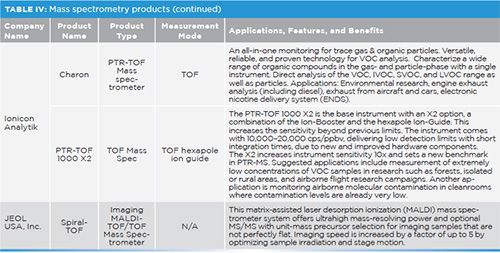

Mid-IR
Mid-IR spectroscopy itself is relatively mature, with sensitivity and signal-to-noise well within the needs of most laboratories. Expansion of mid-IR tools is being explored through multirange capabilities (long possible, but being simplified) and software tools (such as remote operation and cloud processing). There is still a need for inexpensive, task-specific analysis, as the speed, cost, and selectivity
of mid-IR spectroscopy remain its strongest assets.
Brightspec brings a new type of spectroscopy to the analytical world. The isoMRR spectrometer measures rotational spectra to identify species based on differences in their three-dimensional mass distributions, and brings a much higher level of selectivity to isomer and isotope analysis than MS.
EssentOptics has the widest wavelength range (185–5200 nm) in a single instrument. Transmission and absolute reflection measurements at variable AOI’s and polarizations are built-
in capabilities.
PerkinElmer offers a compact, powerful and portable FT-IR spectrometer for routine compositional and quality analyses, as well as a tri-range (NIR, mid-IR, far-IR) FT-IR unit.
Reflex Analytical provides capability to sample, and measure up to 24 samples of biodiesel fuel in one run.
See Table V for listings of mid-IR spectrometers.
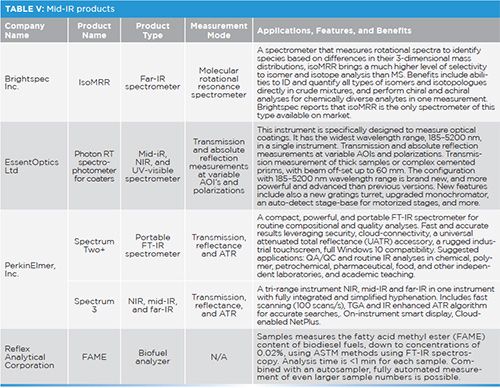
NIR
The NIR category shows some strong trends from multiple vendors. First, smaller, portable instruments are now the mainstay (Avantes, Galaxy, Ocean Insight, and Spectral Evolution, for example). Second, micro electro mechanical systems (MEMS) continue to appear as a key solution, due to lower cost and simple construction (such as in instruments from SouthNest and Ocean Insight). Third, as noted in the mid-IR section, multirange capability is extending the applications space (see Wasatch and Spectral Evolution). All three of these trends have been identified in previous years, as this field appears to be converging on a small number of attributes essential to the task-oriented tools being launched.
Avantes provides a small form factor, high resolution, high sensitivity uncooled InGaAs spectrometer. USB connection makes it easy to integrate into other devices, including original equipment manufacturer (OEM) and handheld applications. This product is well suited for various applications, including food analysis, security monitoring, and the recycling industry.
Galaxy Scientific provides a compact, portable, and high-performance FT-NIR spectrometer with a triggered fiber optic probe for laboratory and field, and a built-in probe holder. This spectrometer is designed from the ground up to offer the industry a new kind of NIR analysis solution.
EssentOptics provides coverage of NIR, UV, visible, and mid-IR (185–5200 nm) in a single instrument. NIR is a subsidiary listing for this product; please see the main listing in mid-IR for more information.
Ocean Insight has launched a compact FT-NIR spectral sensor for qualification and quantification of materials from 1350–2500 nm (7400–4000 cm-1)
The Si-Ware Neospectra scanner is a hardware- and software-ready device that enables field material analysis applications.
SouthNest Technology Ltd provides an FT-IR and NIR system based on MEMS technology. The larger FT-IR mirror size (mm range) allows more light to enter the system to improve signal quality.
Spectral Evolution has made available two field-capable NIR spectrometers. One has high-resolution, for measuring fine distinctions between similar materials. The other is a heavy-duty field-transportable spectrometer, for use in
rugged environments.
Wasatch Photonics has two new, but similar, spectrometers intended for OEM use. They differ in the wavelength range covered; the NIR-only instrument covers 900–1700 nm, while the vis-NIR spectrometer covers the range 350–1000 nm.
See Table VI for listings of NIR spectrometers.
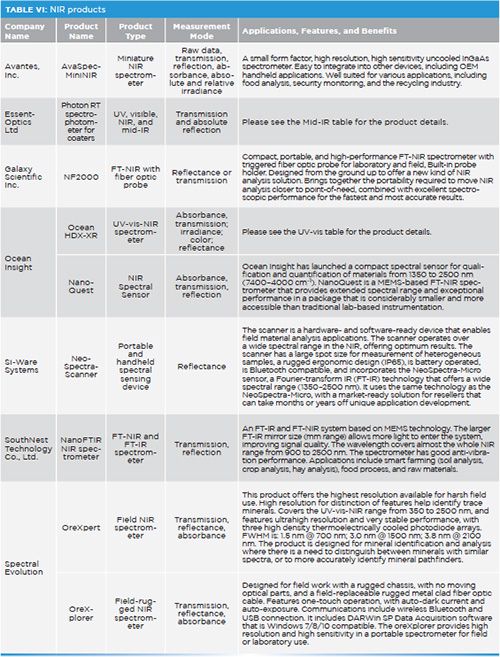

NMR
It was only a few years ago that a nuclear magnetic resonance (NMR) spectrometer required a huge, multi-ton superconducting electromagnet to provide a magnetic field that was sufficiently strong and uniform to allow measurement of NMR signals. Then, a few years ago (first showing up in our 2014 annual review), a breakthrough occurred: Tabletop NMR instruments were demonstrated at Pittcon, in the form of the PicoSpin series from Thermo Fisher Scientific. These instruments were based on the development of very high-flux permanent magnets that required no power or cooling water to generate a magnetic field usable for the NMR measurement.
Fast forward another few years, and another breakthrough in NMR measurement technology was presented at this year’s Pittcon. Waveguide Corporation showed the world’s first handheld, battery-operated NMR analytical instrument, optimized for nonexperts to make decisions in the field at the point-of-use (or point-of-care in medical applications). Applications include authentication of vaccines and biologics, anti-counterfeit, expired or substandard medicine, foods, the petrochemical industry, and medical diagnostics (such as tuberculosis screening and a fast, low-cost, accurate method for the earlier detection of ovarian and other cancers due to the miniaturization of NMR) by a factor of more than 100x. WaveGuide’s NMR operates within minutes between wide ambient and sample temperatures, and only requires ~30 µL of sample.
See Table VII for listings of NMR spectrometers.

Raman Spectroscopy
As we examined the current crop of new instrument submissions, we find a strong emphasis on Raman spectroscopy. This was also true some years ago, when handheld Raman instruments were prevalent. This year, we find multiple new or redesigned benchtop instruments (produced by manufacturers such as Horiba, Renishaw, Kaiser, and Thermo Fisher) as well as an array of accessories (see the Accessories section). The growth in Raman spectroscopy is driven by the continued evolution, in both capability and price, of the components (lasers, detectors, spectrographs, and, critically, software), and a response to penetration of this technique into laboratory space traditionally held by Fourier transform infrared (FT-IR) spectroscopy. The advantages of FT-IR (cost, size, and familiarity with and acceptance by laboratory personnel and regulatory agencies) are being eroded, as simpler and more effective Raman spectroscopy devices are released. Solutions to the need to avoid fluorescence or sample surface irregularities are making the tools more useful in a wider range of laboratories. It is also telling that almost all of the major Raman instrument vendors provide on-line training; this has the impact of creating an informed user base, and also evoking confidence that the vendor has subject matter expertise. This is not orthogonal to product development; it is critical to the companies' messaging.
We expect Raman systems will continue to evolve in two main directions. Handhelds have already penetrated the security market and law enforcement, as well as loading dock quality control (QC). Tabletop units are evolving new imaging tools, better, smarter software, and automation. The new components point the way to new spectrometers, as each vendor seeks an advantage in performance or the elusive “ease of use.”
AcuTech Scientific Inc. provides lightweight, small, handheld Raman spectrometers, with validated libraries available. The Acuscan1350 Gemstone Identifier is specialized in accurate and easy gemstone and mineral identification, and includes a turntable for a 360o scan of a large size gemstone.
Agilent provides a handheld, spatially-offset Raman spectroscopy (SORS) system for QC testing of pharmaceutical, biopharmaceutical, and nutraceutical raw materials through transparent and non-transparent containers.
B&W Tek recently presented Raman spectrometers for the identification of controlled substances, and also for identification of analytes contained in visually opaque containers. They also launched the STRam-1064, which can identify material inside visually opaque barriers such as plastic bottles and paper bags.
Edinburgh Instruments provides a truly confocal design unique to the market, and offers uncompromised spectral resolution, spatial resolution, and sensitivity. The Ramacle RM5 Raman Microscope offers a variable slit and multiple position adjustable pinhole for higher image definition, better fluorescence rejection, and application optimization. The RM5 builds on the expertise of robust and proven building blocks, combined with modern optical design considerations. It has a focus on function, precision and speed.
Horiba presents the LabRam Soleil, which boasts ultrafast Raman imaging (100 times faster imaging). This is the first multi-modal Raman microscope designed to include UV-vis and NIR imaging.
Kaiser Optical Systems supplies a high-resolution, research-grade Raman spectrometer on a portable platform for process development monitoring and control. A single analyzer can collect Raman data from four channels, addressable by fiber-optic probes, and is capable of direct in situ measurements, without needing custom sampling devices.
Metrohm showed the Mira handheld Raman spectrometer, which can identify material in a container with opaque walls.
Ocean Insight (previously Ocean Optics) has a high-sensitivity, 785 nm Raman spectrometer, providing low limits of detection for trace-level materials identification.
Thermo Fisher is showing three models of Raman microscopes: a basic unit, and two intended for special applications, one for real-time analysis and one with automated setup and control features.
Wasatch Photonics presents two Raman spectrometers, one an extended-range Raman spectrometer designed to measure out to 3500 cm-1. The other is similar, but features a fully integrated 350 mW multimode laser that is both powered and controlled through the spectrometer.
WITec’s Truly Confocal Raman microscope offers excellent spectral resolution, spatial resolution and sensitivity.
See Table VIII for listings of Raman spectrometers.
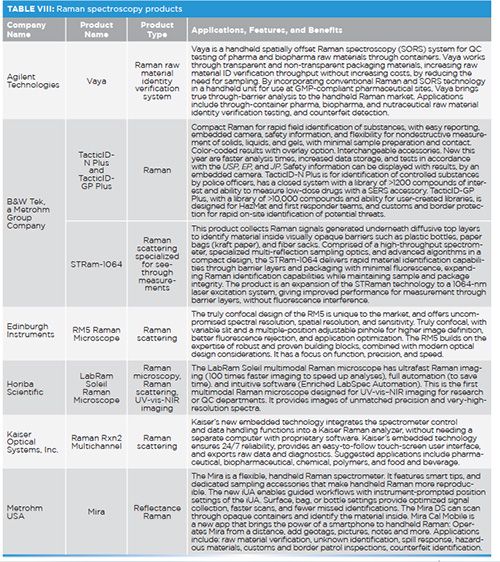
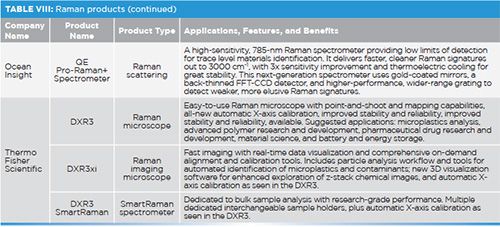
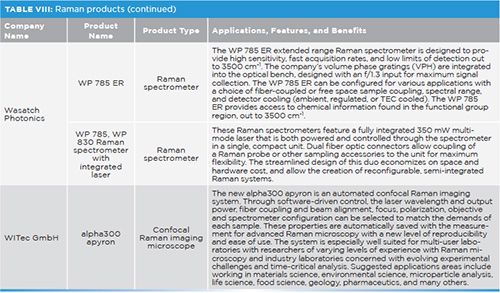
Software
As described in the introduction, software appears to be on the cusp of a major evolution. Vendors have all identified the trend in many laboratories of downsizing staffing, against a continued increase in sample loads. This means a single worker must be able to move between multiple instruments without major barriers. Easy sample transfer and shallow learning curves via workflow software are becoming common needs. As we said earlier in this review, vendor announcements often bury the these features under hardware developments. It becomes immediately apparent, however, when you watch instrument demonstrations that the demonstration is driven by software (“See how easy this is?”). This trend is leading to many changes in the user interface and user experience (UI and UX), as we pointed out in last year’s analysis of trends we were beginning to see: cloud storage, multi-instrument data integration and, slowly, but inevitably, machine learning, where a computer becomes a true laboratory partner. It is an exciting time for both users and vendors.
Software, in the context of this review, consists of several different, albeit related, types of products, including actual computer programs, compilations of spectra, databases, and collections of chemometric calibration models.
Bossart offers NIR calibration development as a service.
Eigenvector has enhanced and upgraded the routines in most of their core products, including PLS Toolbox, Solo, Solo Predictor, MIA Toolbox, and Model Exporter.
Ocean Insight provides a powerful new version of its OceanView spectroscopy software, with a smooth, intuitive graphical user interface (GUI), and provides faster, more stable data acquisition
and processing.
S.T. Japan-Europe GmbH provides spectral databases of illicit drugs, including phenethylamine, synthetic cannabinoids, cathinones, piperazine, tryptamines, mephedrone, steroids, and others.
Thermo Fisher Scientific provides software for its NanoDrop Instrument that simplifies the operation, and extends the capabilities of the instrument.
Tornado Spectral Systems presents a key update of its instrument control software features that offer users standalone operation for continuous manufacturing.
See Table IX for listings of spectroscopy software.
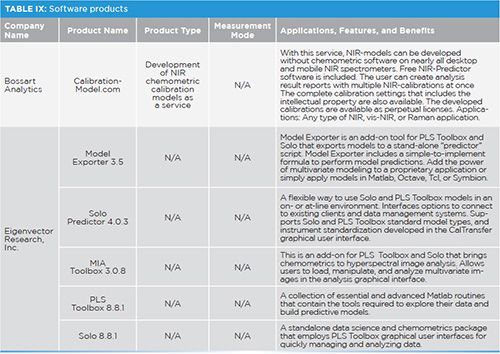
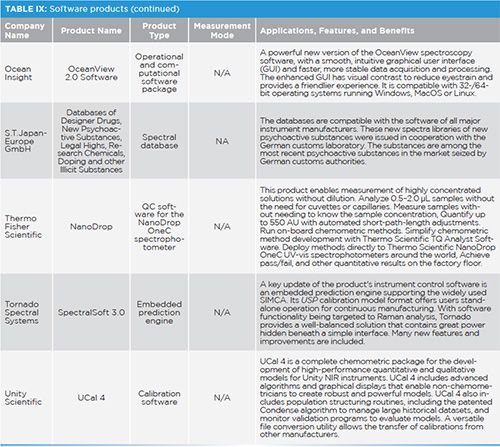
UV-vis
Some entrants in the UV-vis category could have been included under software (Thermo Fisher Scientific) or NIR (see that section for the multirange capabilities). While most emphasize small size and moderate performance, Edinburgh is showing a high-performance unit.
Edinburgh Instruments provides a high-performance dual beam instrument suitable for many analytical applications where accuracy and precision measurements are key to results. Utilizing a
dual lamp and Czerny-Turner configuration monochromator, the instrument features a compact, high throughput optical system, which ensures impressive
spectral performance.
EssentOptics provides coverage of UV, visible, and NIR and mid-IR (185–5200 nm) in a single instrument. Please see the main listing in mid-IR for more information.
McPherson provides deep ultraviolet and vacuum ultraviolet spectrometers with capabilities of vacuum-compatible flow cells, and a motorized and computer-controlled sample chamber.
Ocean Insight announces an extended-wavelength-range version of its high-definition optics spectrometer. The new Ocean HDX-XR uses optimized optical bench components, specialized materials and precision engineering to maximize optical resolution, increased throughput and reduced stray light (>3 AU).
Shimadzu launched four UV-vis spectrometers. The UV-19001 provides high resolution, low stray light, an ultrafast scan function, and an easy-to-use interface. The UV-26000i/2700i double-beam spectrophotometers are true research-grade instruments, and have selectable bandwidths to comply with requirements of regulated laboratories and high-end research. The UV-3600i Plus is equipped with double grating monochromators, and can achieve ultralow stray light levels, constant optical resolution of 0.1 nm or lower in the UV and visible region, and 0.4 nm in the NIR region. The SolidSpec-3700i and SolidSpec-3700i DUV (deep-UV) can measure from deep-UV to visible and up to 3300 nm in the near-IR.
Spectrum Scientific offers a configurable miniaturized spectrometer that can be set up for virtually any type of
UV-vis measurement.
Thermo Fisher Scientific provides software for their NanoDrop Instrument; see the Software section for details.
See Table X for listings of UV-vis spectrometers.
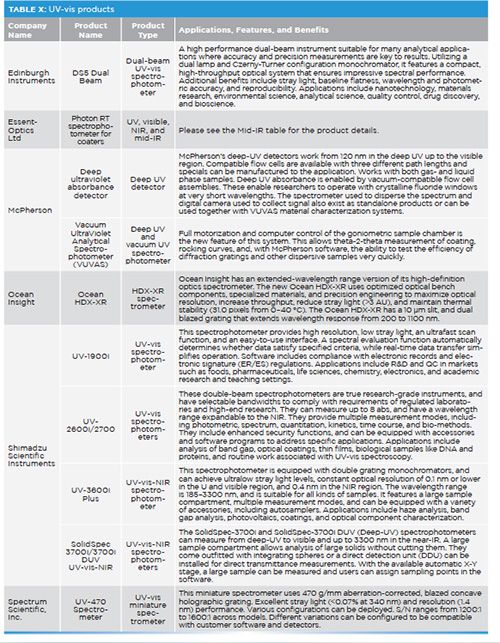
X-ray
The X-ray category is small this year, preventing a general statement.
Elvatech Ltd. provides an instrument to check for compliance to restriction of hazardous substances (RoHS)
specifications.
IXRF Systems provides the Atlas Micro-XRF spectrometer (µXRF) that is used for X-ray mapping and automation.
Spectro Analytical has a new ED-XRF analyzer designed to delivers easy, reliable, and accurate elemental analysis at thigh speed.
See Table XI for the listing of X-ray spectrometers.
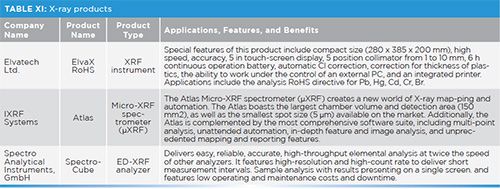
Accessories
This is our largest pool of submissions. Accessories are developed around specific needs or shortcomings in existing tools. Fiber optics (such as those manufactured by Art Photonics and Wasatch)
provide simplicity in sampling. Cuvettes hold samples (Reflex) and hand tools are common (Reflex). Other tools address gas handling (Spetec, Reflex). An interesting item here is a form of packaging: pouches for transport of delicate
items (Alliance).
Alliance Corp provides protective pouches for optics (lenses, mirrors, filters) to keep their surfaces pristine and free from scratches.
Art Photonics offers three different fiber probes: a transflection probe for visible and NIR applications, a Raman fiber probe, and a combined (transflection and Raman) capability.
Coherent provides a Raman probe that can simultaneously collects parallel and cross-polarized signals for both Raman and terahertz probes.
Galaxy Scientific has a new liquid sampler that is used with fiber based FT-NIR spectrometers to analyze samples of liquid-based products. The sampler features a temperature-controlled fiber (coupled main sample chamber), a preheating chamber, and an easy to read 3.2-in touch screen interface where the temperature values are displayed and set.
Reflex Analytical offers several different spectroscopic accessories:
- a four-in-one XRF pellet dies for various pellet sizes
- fluorocarbon O-ring seals and differentially pumped vacuum system that achieve UHV performance at 10–12 cm3/s
- UV-vis-NIR cuvettes and cells, assembled by direct fusion, ensuring resistance to chemical attack
- high-temperature gas cells with 10 cm pathlength.
Savillex provides an acid-vapor cleaning environment, capable of cleaning multiple devices simultaneously.
Spetec now provides new syringe pumps (for precision cell filling) and peristaltic pumps (for injecting samples into flow-through cells).
The Spectral Evolution Sensaprobe is not just a holder for the probe; it also provides active feedback, so you know exactly where on the sample your spectrum is coming from.
Tornado Spectral Systems has an ATEX certified laser safety accessory that provides a safe environment around Class 3B lasers.
Wasatch Photonics offers Raman probes that are highly configurable. These probes offer interchangeable tips and adapters for coupling to a microscope or stage, are available for 405, 532, 633, 785, 830, and 1064 nm excitation, and are matched to f/1.3 Raman spectrometers. Tip options have configurable working distances. Thus, the probe can be configured for the application, from immersion use to microscopy or mapping, with focal lengths ranging from 2–25 mm.
See Table XII for listings of accessories.
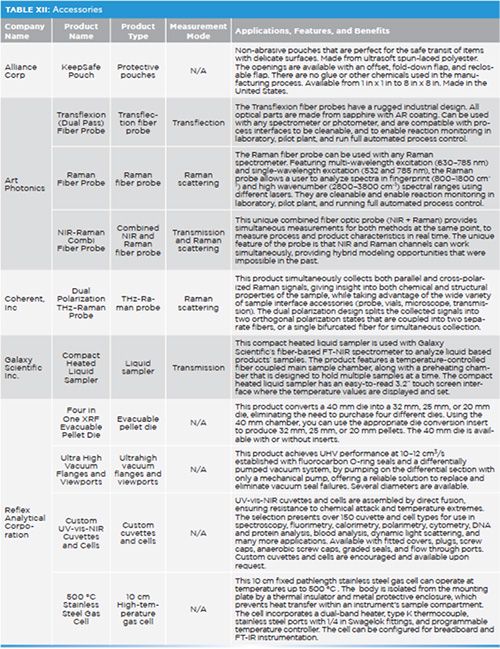
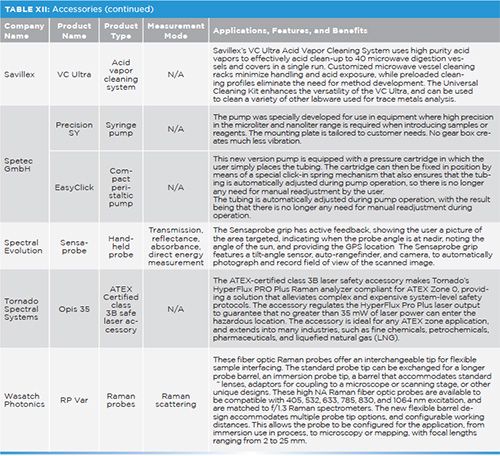
Components
Component manufacturers both lead and follow instrument vendors. New lasers (such as those produced by Eblana, MKS Spectra-Physics, Cobolt, and UniKLasers), new gratings, and optics (produced by Electro-Optics, OPCO, and Spectrolight) often relate to the larger world of Raman spectroscopy and related fields, responding to specific needs, and driving future product developments.
Armadillo Sia offers optical fibers with noncircular cross sections.
Cobolt provides lasers with exceptionally high spectral purity. Purity of this laser is >60 dB as close as 0.3 nm away from the main laser peak.
Enhanced spectral purity (ESP) is a critical specification for low frequency Raman applications.
Eblana Photonics provides custom discrete-mode diode lasers with stable and precise lasing performance over the whole the mid-IR and ZAZ wavelength ranges.
Electro-Optics Technology provides wide range of electro-optic isolators
to cover many different wavelength ranges, featuring ≥95 % transmission and ≥33 dB isolation.
Hamamatsu has developed a FT-NIR spectral engine based on a Michaelson interferometer formed on a silicon bench. This created a tiny and low-cost FT-IR spectrometer, the key benefits of which are portability, wavelength coverage, and high resolution of 5.7 nm (30 cm-1). This engine is 100X more sensitive than competing
FT-IR solutions.
MKS Spectra-Physics presented a new tunable laser, with a repetition rate of 80 MHz, and broadband
tuning from 680–1300 nm, with >3 W of output power at 900 nm (a 50% increase in power over the previous generation).
OPCO Laboratory’s echelle gratings are differentiated in the marketplace by their high efficiency and low scatter.
Spectrolight has a variable filter that allows center wavelength and bandwidth adjustment, spanning the entire visible spectrum. The previous model is compatible with various light sources, while the new models are compatible with lasers only. The maximum beam size for the Laser Version is 3 mm.
UniKLasers Ltd. provides solid-state diode lasers (SSDL); their specifications include advanced remote control operation (GUI),and they deliver more than 8 h of non-stop operation, along with output powers of up to 1000 mW.
See Table XIII for listings of components.
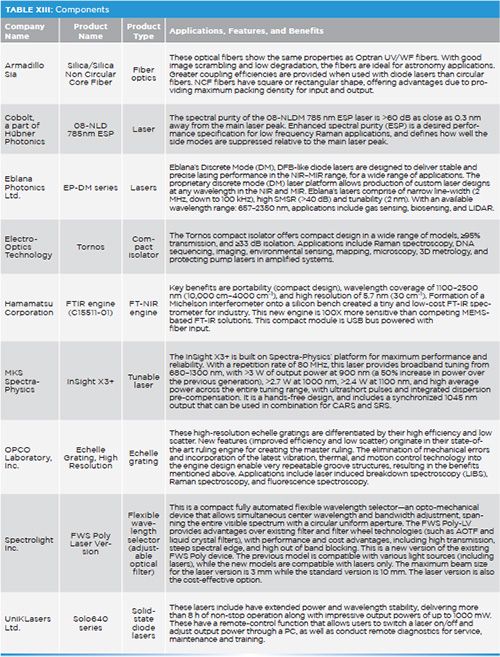
Howard Mark serves on the Editorial Advisory Board of Spectroscopy and is a coauthor of the “Chemometrics in Spectroscopy” column. He also runs a consulting service, Mark Electronics, in Suffern, New York. Michael S. Bradley also serves on Spectroscopy’s Editorial Advisory Board and is a Product Manager at Thermo Fisher Scientific in Madison, Wisconsin. Direct correspondence to SpectroscopyEdit@mmhgroup.com

Newsletter
Get essential updates on the latest spectroscopy technologies, regulatory standards, and best practices—subscribe today to Spectroscopy.
The Rising Role of Near-Infrared Spectroscopy in Biofuel Innovation
July 25th 2025A new bibliometric study published in Infrared Physics & Technology highlights the growing global impact of near-infrared (NIR) spectroscopy in biofuel research, revealing key trends, contributors, and future directions for advancing sustainable energy solutions.
Best of the Week: The Emerging Leader in Molecular Spectroscopy, Big Pharma’s Manufacturing Shift
July 25th 2025Top articles published this week include a feature article about big pharma’s investments in U.S.-based manufacturing, an article about the 2025 Emerging Leader in Molecular Spectroscopy Lingyan Shi, and some news items detailing the winners of the Coblentz Society’s student awards.